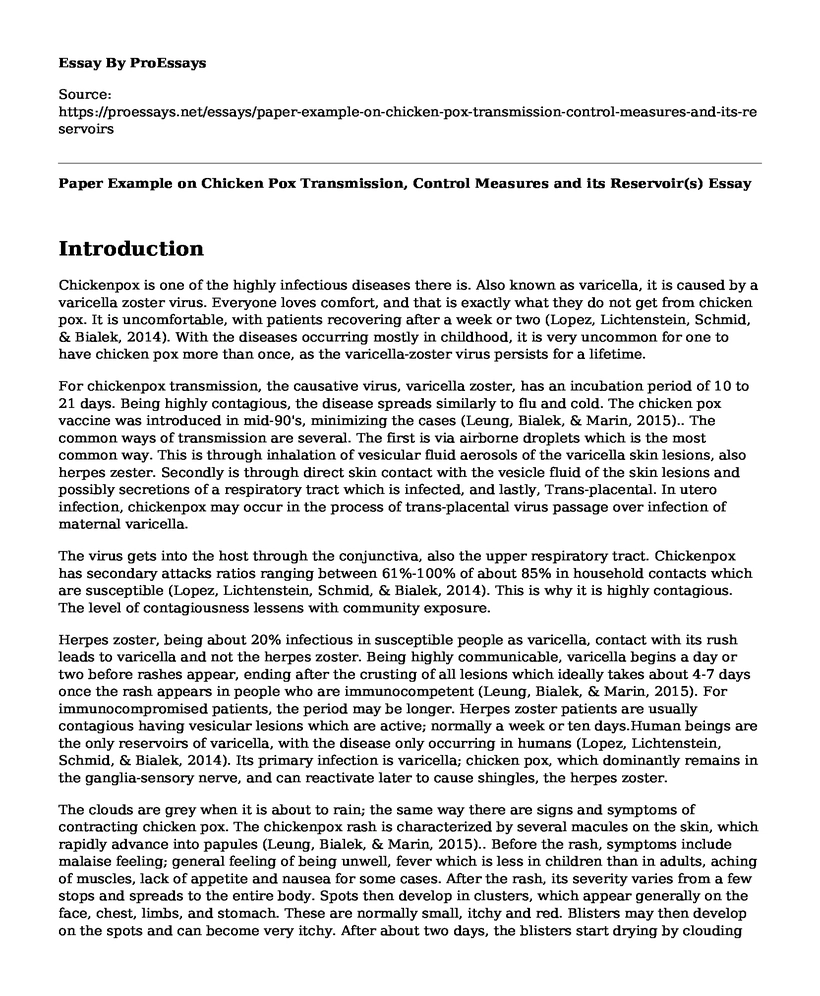Introduction
Chickenpox is one of the highly infectious diseases there is. Also known as varicella, it is caused by a varicella zoster virus. Everyone loves comfort, and that is exactly what they do not get from chicken pox. It is uncomfortable, with patients recovering after a week or two (Lopez, Lichtenstein, Schmid, & Bialek, 2014). With the diseases occurring mostly in childhood, it is very uncommon for one to have chicken pox more than once, as the varicella-zoster virus persists for a lifetime.
For chickenpox transmission, the causative virus, varicella zoster, has an incubation period of 10 to 21 days. Being highly contagious, the disease spreads similarly to flu and cold. The chicken pox vaccine was introduced in mid-90's, minimizing the cases (Leung, Bialek, & Marin, 2015).. The common ways of transmission are several. The first is via airborne droplets which is the most common way. This is through inhalation of vesicular fluid aerosols of the varicella skin lesions, also herpes zester. Secondly is through direct skin contact with the vesicle fluid of the skin lesions and possibly secretions of a respiratory tract which is infected, and lastly, Trans-placental. In utero infection, chickenpox may occur in the process of trans-placental virus passage over infection of maternal varicella.
The virus gets into the host through the conjunctiva, also the upper respiratory tract. Chickenpox has secondary attacks ratios ranging between 61%-100% of about 85% in household contacts which are susceptible (Lopez, Lichtenstein, Schmid, & Bialek, 2014). This is why it is highly contagious. The level of contagiousness lessens with community exposure.
Herpes zoster, being about 20% infectious in susceptible people as varicella, contact with its rush leads to varicella and not the herpes zoster. Being highly communicable, varicella begins a day or two before rashes appear, ending after the crusting of all lesions which ideally takes about 4-7 days once the rash appears in people who are immunocompetent (Leung, Bialek, & Marin, 2015). For immunocompromised patients, the period may be longer. Herpes zoster patients are usually contagious having vesicular lesions which are active; normally a week or ten days.Human beings are the only reservoirs of varicella, with the disease only occurring in humans (Lopez, Lichtenstein, Schmid, & Bialek, 2014). Its primary infection is varicella; chicken pox, which dominantly remains in the ganglia-sensory nerve, and can reactivate later to cause shingles, the herpes zoster.
The clouds are grey when it is about to rain; the same way there are signs and symptoms of contracting chicken pox. The chickenpox rash is characterized by several macules on the skin, which rapidly advance into papules (Leung, Bialek, & Marin, 2015).. Before the rash, symptoms include malaise feeling; general feeling of being unwell, fever which is less in children than in adults, aching of muscles, lack of appetite and nausea for some cases. After the rash, its severity varies from a few stops and spreads to the entire body. Spots then develop in clusters, which appear generally on the face, chest, limbs, and stomach. These are normally small, itchy and red. Blisters may then develop on the spots and can become very itchy. After about two days, the blisters start drying by clouding over to develop crusts, which fall off on their own as one heals.
When it comes to chickenpox control measures, prevention is better than cure, and there are some ways to control chicken pox. Vaccination is the greatest control measure. It is important for everyone to be assessed for chicken pox immunity. Lack of immunity or contradictions with the same should be diagnosed as being administered age-appropriate vaccinations (Leung, Bialek, & Marin, 2015). Varicella vaccine contains attenuated live varicella-zoster virus. Some varicella vaccines include single-antigen which is administered and licensed for those aged 12 months and above and combination measles-mumps-rubella-varicella (MMRV) for children of ages 1-12 years
The post-exposure administration is recommended for unvaccinated people of 12 months and above to modify the disease. People without good immunity showing varicella vaccine complications and are at risk of severe varicella should receive varicella-zoster immune globin such as VariZIG. Research has also found out that universal childhood vaccination programs against vaccination in many countries have led to a sharp decrease in the death rate of varicella (Leung, Bialek, & Marin, 2015). It is, therefore, necessary to take the prevention measure of chicken pox.
References
Leung J, Bialek SR, Marin M. (2015). Trends in varicella mortality in the United States: Data from vital statistics and the national surveillance system. Hum Vaccin Immunother, 11(3), 662-8.
Lopez AS, Lichtenstein M, Schmid SD, Bialek S. (2014). Assessment of varicella surveillance and outbreak control practices - United States. MMWR 2014 Sep 12;63(36):785-8.
Cite this page
Paper Example on Chicken Pox Transmission, Control Measures and its Reservoir(s). (2022, Jul 11). Retrieved from https://proessays.net/essays/paper-example-on-chicken-pox-transmission-control-measures-and-its-reservoirs
If you are the original author of this essay and no longer wish to have it published on the ProEssays website, please click below to request its removal:
- Article Analysis Essay on Spirituality in Nursing
- Role of Social Work Life Skills in Juvenile Recidivism - Research Paper
- Essay Example on Work-Life Balance: A Stressful Reality for Working Mothers
- The Journey to Public Health: A Grandmother's Legacy - Essay Sample
- Bibi & Jean-Dominique: Accepting Disability & Advocating for Oneself - Case Study
- Free Paper Example: A Nurse-Patient Dialogue for Effective Care
- Disease Model of Addiction - Free Essay Example







